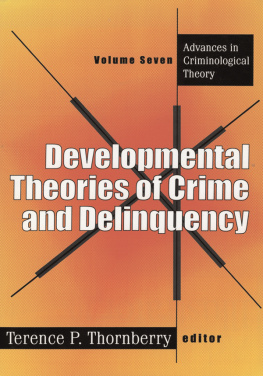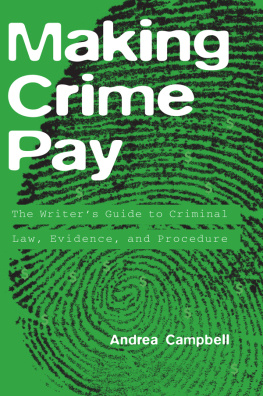Terence P. Thornberry - Developmental Theories of Crime and Delinquency
Here you can read online Terence P. Thornberry - Developmental Theories of Crime and Delinquency full text of the book (entire story) in english for free. Download pdf and epub, get meaning, cover and reviews about this ebook. year: 2004, publisher: Routledge, genre: Home and family. Description of the work, (preface) as well as reviews are available. Best literature library LitArk.com created for fans of good reading and offers a wide selection of genres:
Romance novel
Science fiction
Adventure
Detective
Science
History
Home and family
Prose
Art
Politics
Computer
Non-fiction
Religion
Business
Children
Humor
Choose a favorite category and find really read worthwhile books. Enjoy immersion in the world of imagination, feel the emotions of the characters or learn something new for yourself, make an fascinating discovery.
- Book:Developmental Theories of Crime and Delinquency
- Author:
- Publisher:Routledge
- Genre:
- Year:2004
- Rating:5 / 5
- Favourites:Add to favourites
- Your mark:
Developmental Theories of Crime and Delinquency: summary, description and annotation
We offer to read an annotation, description, summary or preface (depends on what the author of the book "Developmental Theories of Crime and Delinquency" wrote himself). If you haven't found the necessary information about the book — write in the comments, we will try to find it.
In Developmental Theories of Crime and Delinquency, Terence P. Thornberry and his contributors show that criminal behavior is not a static human attribute, but ebbs and flows over the life course of the individual. Criminal behavior tends to follow a distinct psychological pattern. It is relatively uncommon during childhood, is initiated by most offenders during adolescence, flourishes during late adolescence and early childhood, and usually diminishes or disappears by the mid-twenties. This pattern is not characteristic of all people--some never commit crimes and others become career criminals--but it is a general description of the developmental pattern of criminal offenders. This pattern has profound implications for theories of crime and delinquency. Not only does it explain initiation into, maintenance of, and desistance from involvement in crime, it offers insight into why crime flourishes during adolescence. Traditional theories of crime and delinquency have often failed to distinguish among different phases of criminal careers. They tend to ignore developmental changes that occur across a persons life course, changes that coincide with and can explain the causes and patterns of criminal behavior. This paperback edition of the seventh volume of the distinguished series Advances in Criminological Theory moves us from static identifications of the criminal by presenting a broad range of developmental explanations of crime. Each contributor articulates a developmental or life course perspective in explaining how people become involved in delinquency and crime. Each covers a wide range of theoretical territory and reveals how a developmental perspective enhances the explanatory power of traditional theories of crime and delinquency. This volume is an invaluable tool for criminologists, sociologists, psychologists, and other professionals seeking to teach how crime and violence can be understood in our culture.
Terence P. Thornberry: author's other books
Who wrote Developmental Theories of Crime and Delinquency? Find out the surname, the name of the author of the book and a list of all author's works by series.






